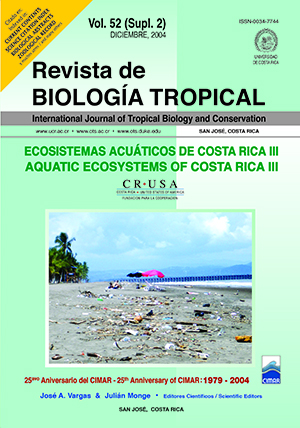Abstract
Using an energy dispersive X-Ray fluorescence analysis, simultaneous evaluation of K, Ca, Ti, Cr, Mn, Ge, Ni, Cu, Zn, Br, Rb, Sr and Pb in 74 marine sediment samples from the Costa Rica intertidal zones was conducted. Samples were collected between June 1999 and December 2001, from Caribbean and Pacific beaches of Costa Rica. Calcium and iron showed the highest abundances and are indicators of the natural origin of the sediments. Calcium is associated with biogenic processes such as coral reefs near the sampling sites and iron indicates a terrigenous origin. In general, the beaches of the Caribbean and North Pacific regions showed the greatest concentration of calcium. This is indicative of the abundant reef structures near these beaches. The beaches of the Central and South Pacific show the greatest iron concentrations, indicating an important lithosphere contribution and/or little contribution of calcium carbonate due to the poor development of coralline structures near the sampling sites. Finally, the analyses did not show evidence of elements associated with anthropogenic pollution. Only a northern section of Puerto Viejo beach showed high concentrations of lead, zinc and titanium, perhaps associated with hydrothermal sources.References
Cortés, J. & C. Jiménez. 2003a. Past, present and future of the coral reefs of the Caribbean coast of Costa Rica. p. 223-239. In J. Cortés (ed.). Latin American Coral Reefs. Elsevier Science B.V., Amsterdam.
Cortés, J. & C. Jiménez. 2003b. Corals and coral reefs of the Pacific of Costa Rica: history, research and status. p. 361-385. In J. Cortés (ed.). Latin American Coral Reefs. Elsevier Science. 497 p.
Cortés, J. & A. León. 2002. Arrecifes coralinos del Caribe de Costa Rica/ The Coral Reefs of Costa Rica’s Caribean Coast. Edit. INBio, Heredia, Costa Rica. 139 p.
Cortés, J. & M. M. Murillo. 1985. Comunidades coralinas y arrecifes del Pacífico de Costa Rica. Rev. Biol. Trop. 33: 197-202.
Cortés, J. & H. M. Guzmán. 1985. Arrecifes coralinos de la costa Atlántica de Costa Rica. Brenesia. 23: 275-292.
Cortés, J. & M. J. Risk. 1985. A reef under siltation stress: Cahuita, Costa Rica. Bull. Mar. Sci. 36: 339-356. Cortés, J., R. Soto & C. Jiménez. 1994. Efecto Ecológicos del Terremoto de Limón. Geol. Amér. Central. Vol. Esp. Terremoto de Limón, Costa Rica: 187-192.
Cortés, J., A. C. Fonseca, M. Barrantes & P. Denyer. 1998. Type, distribution, and origin of sediments of the Gandoca-Manzanillo National Wildlife Refuge, Limón, Costa Rica. Rev. Biol. Trop. 46. Supl. 6: 251-256.
Denyer, P. & G. Cárdenes. 2000. Costas marinas. p 185- 218. In P. Denyer & S. Kussmaul (eds.). Geología de Costa Rica. Instituto Tecnológico de Costa Rica, Cartago, Costa Rica.
García-Céspedes, J., J. Acuña-González & J.A. Vargas- Zamora. 2004. Metales traza en sedimentos costeros de Costa Rica. Rev. Biol. Trop. 52 (Supl. 3A): 51-60.
Jenkins, R., R. W. Gould & D. Gecke. 1981. Quantitative X-Ray Spectrometry. Marcel Dekker, Inc. Nueva- York, USA. 450-457.
Heikoop, J. M. 1991. Evidence of longshore drift in beach sediment: Manzanillo, Costa Rica. B.Sc. Thesis. Mc- Master University, Ontario. 44 p.
Heikoop, J. M. & M. J. Risk. 1993. Heavy minerals as indicator of longshore drift in beach sediment at Manzanillo, Limon Province, Costa Rica. Brenesia. 39-40: 51-58.
Komar, P. D. 1976. Beach processes and sedimentation. Printice-Hall, Inc. Nueva Jersey. 429 p.
Koopman, C. & A. Orange. 1991. Multielement determination in sediments from German Wadden Sea, investigations on sample preparation techniques. Spectrochimica Acta. 46B: 1395-1402.
Laguna, J. E. 2000. Geoquímica. p 411-423. In P. Denyer & S. Kussmaul (eds.). Geología de Costa Rica. Instituto Tecnológico de Costa Rica, Cartago, Costa Rica. Linkimer, L. & T. Aguilar. Estratigrafía sedimentaria. p 43-62. In P. Denyer & S. Kussmaul (eds.). Geología de Costa Rica. Instituto Tecnológico de Costa Rica, Cartago, Costa Rica.
Obando, L. G. 2000. Minerales. p 17-42. In P. Denyer & S. Kussmaul (eds.). Geología de Costa Rica. Tecnológico de Costa Rica, Cartago, Costa Rica.
Riba, I., V. Zitko, J. M. Forja & T. A. DelValls. 2003. Deriving sediment quality guidelines in the Guadalquivir estuary associates with Asnalcóllar mining spill: A comparison of differente approaches. Ciencias Marinas. 29: 261-274.
Ryan, J. D. & H. L. Windom. 1988. Ageochemical and statistical approach for assessing metal pollution in Coastal Sediments. p. 47-58. In Seeliger, U., L. D. de Lacerda & S. R. Patchineelam (ed.). Metal in Coastal Environments of Latin America. Springer. Londres.
Stanley, D. J. & D. J. P. Swift. 1976. Marine sediment transport and environmental management. John Wiley & Sons. Nueva York, USA. 592 p.
##plugins.facebook.comentarios##

This work is licensed under a Creative Commons Attribution 4.0 International License.
Copyright (c) 2004 Revista de Biología Tropical


